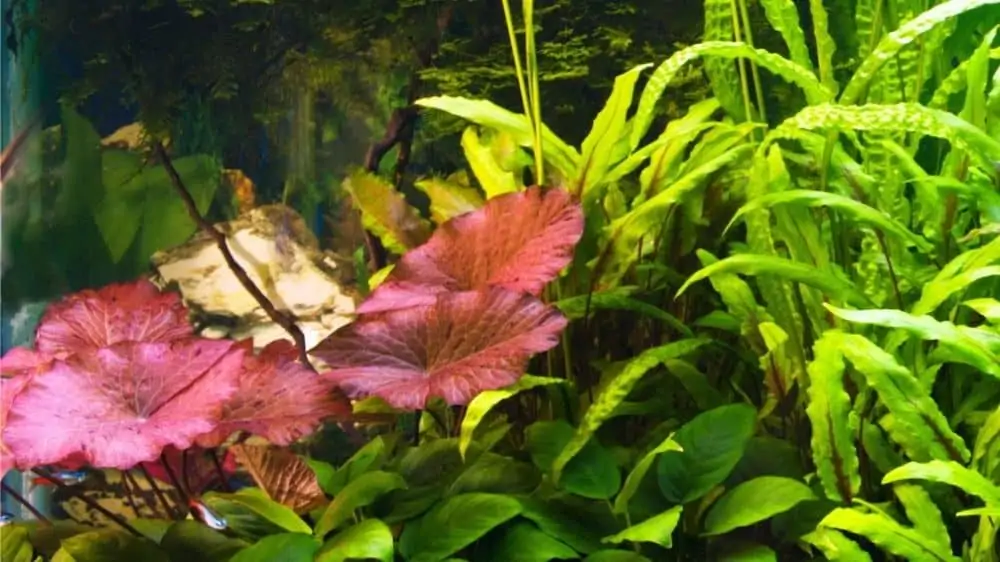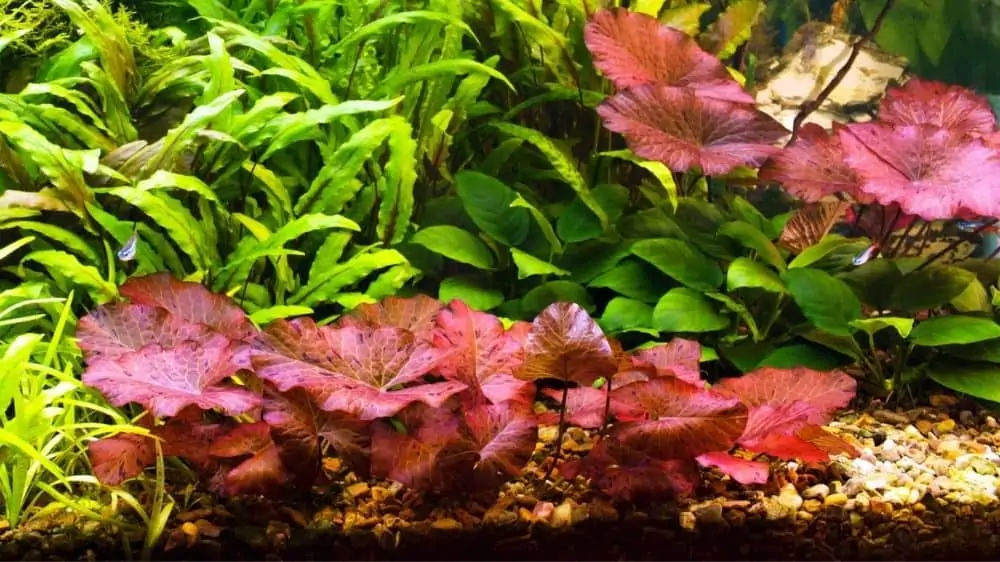If you’re looking for an unusual aquarium plant to use as a centerpiece in your aquarium, you’re in luck.
The red tiger lotus is an eye-catcher with its bright red colors and interesting leaf contours. These plants are colorful, easy to care for, fast-growers, and great additions to the planted tank for both those with experience in the fishkeeping hobby and those who are beginners! Plus, they just make a nice conversation piece.
Keep reading for everything you need to know about planting and taking care of red tiger lotus in your freshwater aquarium!

What is red tiger lotus?
Nymphaea zenkeri, commonly known as the red tiger lotus, is a little different from aquarium species.
As a member of the Nymphaea genus, these plants will grow submerged leaves as well as floating leaves. This can make identifying them a little more challenging if you’re not sure what you’re looking for.
The red tiger lotus gets its name from its deep red leaves; most varieties will have red leaves, but some might have green leaves with striations of red. Submerged leaves have a beautiful ruffled look that can add a lot of texture to the fish tank.
If allowed to grow to the surface of the tank, the red tiger lotus will produce a flower, typically in between white and yellow coloration; some rarer varieties might even give a lush pink or purple flower.
Red tiger lotus natural habitat
These plants are native to Africa, where they enjoy slow to stagnant water with relatively shallow depths. This allows for their bulbs to grow two feet (61 centimeters) from the aquarium substrate to the surface of the water.
At the surface, their leaves can grow an impressive 2 feet (61 centimeters) across. While these plants are easily maintained to stay at smaller sizes, they are fast growers and need to be trimmed daily in some cases.
It should also be noted that they do best when supplemented with iron and other fertilizers as well as carbon dioxide to keep their bright colors.
Planting red tiger lotus

Planting red tiger lotus is a bit different from planting most other aquarium plants. This lotus grows from a small bulb, which is often sold and/or shipped without any leaves.
When planting this bulb, don’t place it all the way into the substrate as this can result in rot. Instead, push it down about 25-50% of the way and leave the rest sticking out. Once the root systems become more developed, you may push the bulb down farther down into the substrate.
If you don’t want to keep your lotus in the substrate, then many hobbyists also have success leaving it sitting on top of the substrate, gently weighted down by a rock, driftwood, or another soft object.
Because red tiger lotus grows very large, some aquarists prefer to plant it in a small container, like a glass or plastic container, though this is not necessary.
Red Tiger Lotus Tank Requirements and Water Parameters
Red plants have a reputation for being more demanding than other species of green plants in the aquarium hobby. While this is true for the most part, the red tiger lotus is one of the more forgiving species that will still add that pop of color you’re looking for.
While easy to care for and a fast-grower, there are some requirements to maintain its phenomenal growth rate and color intensity.
Temperature
The red tiger lotus is a tropical plant native to Africa and needs a stable temperature between 72 and 82 degrees Fahrenheit (22.2 to 27.8 degrees Celsius).
These plants will go into a dormant state if temperatures fall too far below this range.
Ideal Substrate
Red tiger lotus can get big and should be given a good amount of space in the aquarium to fully expand and grow. They will do best as a mid- or background plant.
The type of substrate you use doesn’t matter too much, though it might be safer and easier to plant a bulb in sand or dirt.
Because this lotus plant is primarily a root feeder, a nutrient-rich substrate, like organic potting soil, might be good to jumpstart growth; however, as we’ll discuss later, a root fertilizer tab might be easier to dose.
Lighting
Though red tiger lotus will grow in low lighting conditions, it won’t reach its true potential in size, shape, or color.
Because the plant needs to reach for the light in lower lighting conditions, it will become leggy and lose its compact shape. As a result, its growth rate will also suffer and you won’t get the big, ruffled leaves that this plant is known for.
To get better plant growth in the long run, it’s recommended to ditch the low-light tank setup and opt for medium to high lighting instead.
Nutrients and carbon dioxide
Red tiger lotus isn’t a demanding plant in terms of nutrients and carbon dioxide dosing, but any beneficial supplements will help the plant maintain its color and keep a faster growth rate.
Specifically, iron will help these gorgeous plants retain their color best. This can be dosed in the form of a liquid or root tab fertilizer, though root tabs can be absorbed directly by the bulb and root structure of the plant.
Carbon dioxide may also be dosed to improve color even more while keeping lively and bushy leaves growing; carbon dioxide might be especially useful if there are many other plant species in the tank as well.
How many nutrients you need to dose is entirely up to your system. Since these plants need higher light, algae can be difficult to deal with and should be expected in the first few months of finding a balance between nutrient import and export.
Propagation
Because red tiger lotus has such a high potential rate of growth, propagation is relatively fast and straightforward.
Red tiger lotus blossoms can be harvested for their seeds after they wilt, but not many aquarium hobbyists allow their plants to grow flowers. To prevent your plant from reproducing in this way, it’s best to remove the flower before it has time to wilt and for seeds to be dispersed.
Instead of waiting for blossoms to seed, the most popular method of propagation is through their root systems, the bulb.
This method is very easy and is only a matter of taking good care of your lotus and having patience. Once your plant has settled and tank conditions are right, the healthy bulb will start to develop dividing bulbs; these bulbs may start to grow their own leaves as well.
Propagation is as simple as carefully removing these tiny bulbs and moving them to the new desired location.
Pruning
Pruning is very important for these plants as they can quickly shadow other plants and start to take up available nutrients. Pruning is necessary for both live and dying leaves.
If left to grow, your red tiger lotus will naturally find its way up to the surface of the water. This can cause other foreground plants to become overshadowed, which can affect size, shape, and color.
New growth in your lotus also requires increased amounts of nutrients which ultimately takes away from the other beautiful plants in your aquarium.
How do you prune a red tiger lotus?
Not only does pruning keep your system balanced, but it also controls the overall appearance of the plant. Many hobbyists choose to keep these lotuses as completely submerged plants as they can to create bushes of color throughout the tank.
As mentioned before, these plants can grow very quickly under the right conditions and daily pruning might be required to keep your plant growing how you want it.
Luckily, pruning is as simple as cutting leaves when they become too clustered. Make sure to cut in moderation as your plants need their leaves to photosynthesize!
Lastly, pruning dying and dead leaves is important. Removing the damaged leaf will keep the plant from exhausting energy on trying to repair it, which can be channeled into new growth instead.
Rotting leaves can also lead to issues with your tank water if left unresolved.
How can you bring out the red in your red tiger lotus?
Plants will look their best when given the best conditions. This means making sure that it’s getting enough light, nutrients, and carbon dioxide; these plants especially love iron!
When all requirements are met, the leaf color intensity should show it. However, other factors can always affect your plant, like possible disease and lighting quality.

Common problems with red tiger lotus
While these tiger lotuses are pretty easy to get established in your aquarium, there are some problems that you might come across.
Overgrowth
As mentioned before, these plants grow fast once placed into optimal water conditions.
While its impressive growth can make for an eye-catching centerpiece plant, nutrients can quickly become depleted and root tab fertilizers are often recommended. Not only does your lotus use nutrients for optimal plant growth, but it also uses carbon dioxide and light.
Remember that carbon dioxide is also needed by all the other species of plant within your tank for photosynthesis. However, if you do not have a carbon dioxide system, then it can be difficult to keep up with the carbon dioxide demand of this fast-growing plant.
As the tiger lotus grows, it will also start to shade other plants below it with both its floating and submersed leaves. Since tiger lotuses are a popular mid- and background species, foreground plants can be blocked out for light which can hinder growth and color.
Fluctuating water temperatures
Red tiger lotus is one of the more sensitive plants available in terms of water temperature conditions. Because these plants are from Africa, they are used to stable, warm temperatures between 72 and 82 degrees Fahrenheit (22.2 to 27.8 degrees Celsius).
If temperatures start to deviate too much from this range, the lotus may enter a state of dormancy and drop all of its leaves. Once temperatures start to rise again, the bulb should start to produce new leaves.
This can make keeping red tiger lotus as pond plants difficult in climates that experience seasons. Though as bulb plants, they should grow back with warmer temperatures.
Misnaming
Red tiger lotuses can be difficult to come by and correctly identify in some areas.
Many times, these plants are just sold as a bulb without any leaf growth, which can make it difficult to tell apart from other Nymphaea species. Even if early leaves are present on juvenile plants, it can still be hard to know if you’re getting an actual tiger lotus or something else.
The best way to ensure that you’re getting a Nymphaea zenkeri is by going to a reputable seller.
Conclusion
You may not have known that lotuses and lily pads could have been kept in an aquarium setting, but with proper maintenance and care, they make for a beautiful and versatile plant!
Red tiger lotuses can be trimmed to stay completely underwater or left to grow to produce blossoms at the top. While they grow fast, they can be difficult to keep up with pruning and supplying enough nutrients and carbon dioxide.
If you have any questions about the red tiger lotus, other types of lotus, or water lily (like the dwarf aquarium lily, for example), or have had experience keeping Nymphaea in your aquarium or pond, don’t hesitate to leave a comment below!



Bulbs planted as recommend 3weeks ago and they haven’t started showing any signs of growing any leaves
Hi Paul!
Try turning the bulb over for another week or two in the substrate and see if that does anything. If nothing still happens, take the bulb out and smell it to see if it smells rotten.
You could just have a bad bulb.
Hi my Tiger Nymphaea is loosing its leaves. It was so big and beautiful and now it’s sad.
The temperature is 28C, I’m injecting near the roots (bulb) both fertilizer (NPG) and Micro elements, CO2 is injected during light on time, but no results.
Help!
Hi Avi,
Would you be able to tell a little more about the system? What are your water parameters? Have you changed anything recently? Are other plants losing their leaves? Hopefully, we can get to the bottom of this :-).